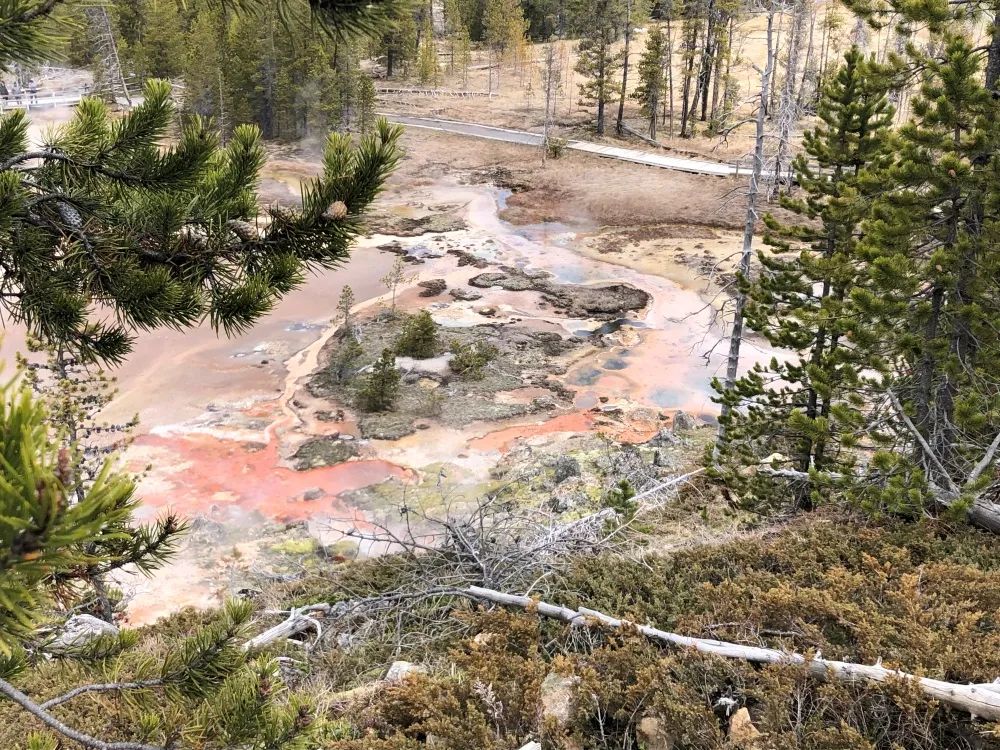
Life in the Extremes
August 2022
article & photo by stephanie hobby
In the early days of NASA, when scientists were embroiled in the Space Race with the Soviet Union, and preparing for a moon landing, no one considered what other life forms we might accidentally be sending up with the astronauts. It was assumed that nothing could survive the trip outside the spacecraft, where the lack of water and extreme heat and cold associated with such a voyage would decimate anything alive.
The commonly held beliefs about what life could tolerate were completely upended during a 1964 vacation to Yellowstone National Park. Dr. Thomas Brock, a microbiologist and bacteriologist at Indiana University in Bloomington had gotten out of his car and overheard a park ranger reference a nearby thermal pool, saying that the vivid color was likely from blue-green algae. Surprised that anything could live - and seemingly thrive - at such temperatures, Brock’s scientist brain was immediately curious.
As a microbiologist, he aimed to study this fascinating, simple ecosystem where predators weren’t a significant concern. Little did he know what he was about to start. Within a few years, Brock would take his place in history after isolating one particular bacteria: the Thermus aquaticus. The bacteria were living in 158 degrees Fahrenheit water, the hottest known environment to host life at the time.
In the years that followed, microbiologists had to unlearn everything they thought they knew about the limits of life. And what they did learn is astounding. Microbes can proliferate in extremely high temperatures, and some also do just fine in frigid, dark environments. Scientists found bacteria living a half-mile below the surface in Antarctic ice about a decade ago. Researchers have also observed microbes flourishing in exceptionally arid environments and at both ends of the pH scale. It’s hard to imagine anything with a pH that rivals drain cleaner, which burns our skin on contact, hosting anything living.
But remarkably, it does. According to the National Park Service, waters in Yellowstone range from around 1 on the pH scale, comparable to a car battery’s acid, to a 14, akin to drain cleaner. With more geothermal features in Yellowstone than in the rest of the world combined, it’s unsurprising that most of these exotic lifeforms are being discovered within the Park.
Broadly known as thermophiles (Thermo meaning “heat” and philes meaning “loving”), the single-celled creatures populating Yellowstone’s thermal features are wildly different from us. Their genes and proteins make it possible for their cells to stand up to the harshest conditions found in Yellowstone. Understanding how life can thrive on the edge is key to various scientific disciplines and has been crucial to medical research today. In the nearly 60 years since Brock’s initial work, interest in these organisms has only intensified.
One discovery has literally changed the world and revolutionized the field of molecular biology. Decades after Dr. Brock’s finding, another scientist, Dr. Kary Mullis, isolated a particular enzyme found in Thermus aquaticus, making it possible for cells to proliferate at high temperatures. This led to the invention of the Polymerase Chain Reaction, or PCR, which earned Mullis a Nobel Prize in Chemistry in 1993.
When exposed to extreme heat, DNA splits into two separate strands. The enzyme Taq polymerase then builds complementing strands. Repeat this process 30-40 times, and you can end up with more than one billion copies of the original DNA snippet over a few hours.
This “molecular copy machine” is wonderfully useful across a broad spectrum of fields. It helps crime scene investigators, who rely on tiny DNA fragments, identify criminals. It’s vital to cancer screening, biomedical research, and early detection of infectious diseases. And if the PCR test sounds familiar, it’s because this is the process used to identify the tiniest viral loads. It was the PCR test that became the gold standard for COVID-19 detection.
Whether you are venturing to the colorful thermal pools or the stinky mud pots, you see an incredibly diverse ecosystem right at your feet. These lifeforms often coexist next to one another as the water temperature or acidity changes. This is why Grand Prismatic Spring is known worldwide for its stunning rainbow effect; as the temperature on the shallower edges cools, it becomes ideal for different colored species to congregate, seamlessly changing from the spring’s signature bright yellows and oranges, and browns. One channel of water can be home to hundreds of kinds of microbes.
It’s true that they are hardy creatures to live in such environments, but they’re also fragile and in need of protection. There’s a good chance that Yellowstone might be the only place some of these microbes can be found. Understandably, damaging them can carry hefty penalties, so visitors are warned not to touch the mats. Not only are they beautiful, but they are also still the subject of intense scientific research. They could lead to the next generation of medical treatments and diagnostics, not to mention unforeseen future endeavors.
So the next time you’re in the Park, scanning through binoculars to spot the bears, wolves, bison, and other iconic Yellowstone wildlife, make sure to take a moment to appreciate the humble (but possibly most impressive) life the Park offers, just inches from the boardwalk.
Originally printed in the August 2022 issue of Simply Local Magazine
Never miss an issue, check out SLM's digital editions here!





